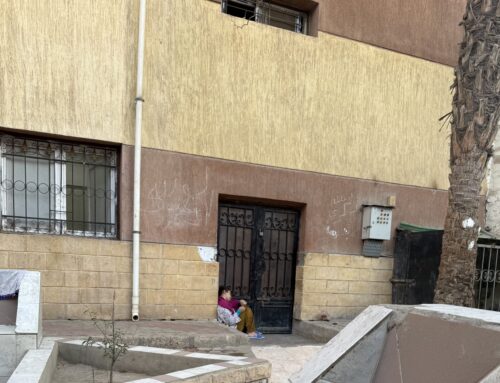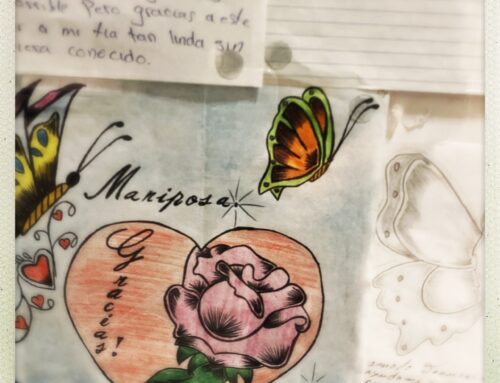It was the autumn of 2021. As I walked through the crowded streets on that gloomy day in Milan, I held my umbrella to protect my leather notebook containing notes, biographical excerpts, and jottings gathered over months and years of fieldwork. I took the tram into the center, where I had arranged to meet Venera in a bar to have breakfast together.
I had gotten to know Venera a few years earlier, in February 2018, during my first day as a volunteer at an anti-violence center located in the historic center of Milan. On that day, Venera was accompanied by her young daughter. Both wore flowing skirts, had long straight black hair, pale complexions, and lively black eyes. As they entered the women’s center I approached Venera and began a conversation. That moment marked the beginning of a long series of encounters during which we slowly unraveled her intricate life trajectory: a story so intimate and poignant that it challenged the very limits of listening, writing, and the ethical responsibility of using her narrative.
Venera, a young migrant woman from Albania who had survived multiple forms of gender-based violence and discrimination, was under the care of both a psychiatrist and a psychologist. Yet, nothing seemed effective in helping her overcome her trauma. The symptoms of posttraumatic stress disorder—nightmares, flashbacks, tremors, and palpitations—continued to punctuate her daily life, preventing her from finding serenity.
How much could Venera tell me about her past, marked by her undocumented status in Italy, the use of false documents, and her experiences as a sex worker to please the father of her daughter? How much could I ask about the man who dragged her into sex work trafficking, took all her earnings, beat her, and tried to set her on fire when she reported him to the police? How much could I write about that trauma?
As a ‘story taker,’ I often felt emotionally overwhelmed and vulnerable while listening to narratives of intimate suffering and daily violence, violence inflicted not only within intimate relationships but also by families and the wider society.
My vulnerability, however, was not the same as hers. I held a privileged position in society, a citizen with rights, while she had spent years living undocumented, afraid to access healthcare or even walk freely in public for fear of being stopped by the police. She told me, “After I moved to Milan, anything abnormal had to be accepted as normal. Violence, disgust, ugliness became part of my everyday life.” Her words stayed with me as a reminder that trauma is woven more deeply into the fabric of some lives than others, depending on their social position and the unequal structures that shape their experiences.
The small desk that Venera and I shared during the interviews, where I placed my recorder, pen, and notebook, and where she rested her slender, pale hands adorned with black nail polish and rings, became the field where our limits, vulnerabilities, indelible pain, and hopes were negotiated. Self-reflexivity and boundaries materialized on it in the moments when my own hands sometimes trembled and writing became difficult. That desk also grew wet with our tears, marking the emotional weight of the process.

Love hanging by a thread. Photo by Debby Hudson (2 February 2018) on Unsplash.
A long time after that series of meetings, while I was still conducting my field research, I decided to send Venera the draft of her story. Through my written text, I tried to explain to her that while her story was undeniably unique, it also resonated deeply with the narratives of many other survivors of gender-based violence. I arranged a late morning breakfast with Venera on a rainy November day in 2021. I sipped my coffee and tried to pretend to be calm, but I was eager to see if she was pleased with what I had written about her painful past.
She sensed my anxiety, smiled, and said: “You’ve put so much effort into writing my story, far more than the social workers and psychologists at the women’s shelter. I hadn’t even considered the difficulties of being a migrant woman with an illegal job. I didn’t understand many things about immigration and violence.”
I continued to listen to what Venera had to tell me. “I felt like the main character of a story. A bad story. Poor Venera of those times, but that little girl has grown up and is now a strong woman.”
Venera said that she loved reading her story, but that I had forgotten a very important part: “You missed the happy ending! While my friends are still stuck in that life, I’ve moved on since meeting my future husband. I’m done with that life, forever. I know I’m worth it. That’s all in the past now. I’ve got my daughter and another little one on the way to focus on. I’m doing alright, though not always… I feel like I have to cure the deepest trauma.”
Today, as I reflect on all the stories I collected, I realize that Venera’s narrative exemplifies how vulnerability materializes through intersectional, nuanced, and multifaceted processes of surviving. My participants’ narratives reveal the complexity of female subjectivity as it becomes entangled with national and international discourses on violence against women, victimhood, vulnerability, and female mental health.
Venera offered a situated and intimate account challenging dominant narratives that underpin humanitarian discourses on resistance and recovery. She revealed to me the non-linear process of rupture and repair standing in contrast to the linear path of recovery often expected by mental health professionals. While dominant frameworks tend to conceptualize recovery as a steady, upward progression toward a fixed goal, Venera’s story instead demonstrates that everyday resistance to violence is an ongoing negotiation with the multiple barriers and structural forces that continually marginalize migrant women.
Doing fieldwork among trauma survivors, I came to understand that vulnerability is not a fixed state, but rather a process intimately tied to the act of existing. Everyone involved in this fieldwork encountered vulnerability as a condition of being-in-the-world (Merleau-Ponty 1962, 94–95), a reality that deeply shaped my subjectivity and my capacity to process emotions while being exposed to Venera’s suffering. Throughout this experience, I witnessed how embodiment functions both for the participants and for myself. Venera’s descriptions of her psychological and physical distress illuminated how embodied trauma persisted over time, manifesting through symptoms commonly associated with post-traumatic stress disorder. Trauma, whether experienced as an event, a narrative, or a memory, is inherently contingent and rooted in the body. Women’s shared stories become entangled with the lives of those who listen to them.
While the relationship between researcher and participant is inherently asymmetrical, and my experience of vicarious trauma cannot be equated with the lived experiences of survivors, these narratives deeply affected me. They led to anxiety, intrusive thoughts following interviews, and physical symptoms such as shivering and a trembling voice. My ethnographic process was shaped by an ongoing awareness of my own limitations in grasping participants’ perspectives, and by critical reflection on the boundaries of ethnographic inquiry itself. Gender, age, nationality, social status, imagination, memory, and subjectivity all played a role in shaping both my position and the research process.
A growing sense of ethical uncertainty about the boundaries of my role intensified as my fieldwork progressed. Ruth Behar (1996, 6) asked in The Vulnerable Observer, “Are there limits—of respect, piety, pathos— that should not be crossed, even to leave a record? But if you can’t stop the horror, shouldn’t you at least document it?” I felt unable to offer Venera any concrete help, and I began to wonder how ethical it was to ask her to recall such painful events. But she wanted to share her story because it represented the possibility of imagining a future beyond violence. Thus, I was there to witness her acts of hope. I was there to document that even trauma and mental health struggles do not stand in opposition to the hope of building a better future.
This act of documenting others’ pain, hoping it might positively impact survivors’ lives, only partially addresses the problem of boundaries and the violence inherent in the intrusive nature of fieldwork. Recalling trauma can indeed act as a trigger for the retraumatization of survivors and can lead to secondary or vicarious trauma in the anthropologist collecting these testimonies. The trauma I listened to did not remain confined to the pages of my notebook. Some words, as we know, take on flesh, become embodied, and stay with us throughout our lives. They return to our thoughts, reshaping aspects of our perspective on the world.
Conducting research in the clinical space of the anti-violence center, I felt in part like a patient too, reflecting on my own trauma, however small in comparison to the deep personal ruptures the women carry with them. Within the clinical space, my agency was constrained. My presence shaped the environment while also limiting my role. As I navigated the field, it became increasingly clear that the role of an impartial, ‘invisible’ observer did not reflect the lived reality of doing fieldwork. This led me to reflect on the nature of the researcher’s agency and its inherent constraints. My presence in the anti-violence center altered the dynamics between the social actors involved—myself, the women seeking psychological support, and the professionals—even when I sat silently, taking notes during counselling sessions. I began to conceptualize myself as a ‘vulnerable observer,’ a researcher who engages in a process of knowing that is inevitably shaped by her own emotions, histories, and encounters with participants.
Trauma is differentially produced, experienced, and pathologized in ways that reflect broader power relations, an insight echoed across the stories I gathered during fieldwork. I came to realize that the complex entanglement between a woman’s life and her traumatic experiences is often overlooked by mental health professionals. As Arthur Kleinman (1988) observed in his work on illness narratives, there is a tendency to disregard the deeper, personal dimensions of suffering. This realization prompted me to pay close attention to the subtle details embedded in survivors’ stories during and after therapy sessions. These narratives reveal trauma not as a universal or abstract condition, but as a deeply situated human experience that is unequally distributed due to intersecting structures of marginalization.
When the fieldwork concluded and the writing process began, I was haunted by questions: What should I do with all these stories? How much should I reveal of what I had heard? These questions lingered within me, pressing against the process of writing. The only respite was the hope that, in a society where female voices are so often diminished and silenced, they might find space within my pages.
If these stories were written down (Borghi 2024), it is because they nurtured a fragile hope at the margins of a society that tried to erase them.
References
Behar, Ruth. 1996. The Vulnerable Observer: Anthropology That Breaks Your Heart. Beacon Press.
Borghi, Emanuela Nadia. 2024. “Engaging with Trauma: From Reflections on a Survivor’s Experience of Child Sexual Abuse to Developing a Trauma-Informed Approach for Anthropological Teaching and Research.” Teaching Anthropology 13(2): 63-74.
Kleinman, Arthur. 1988. The Illness Narratives: Suffering, Healing, and the Human Condition. Basic Books.
Merleau-Ponty, Maurice. 1962. Phenomenology of Perception. Translated by Colin Smith. Routledge & Kegan Paul.
Emanuela Nadia Borghi is an Associate Lecturer at the University of St. Andrews (UK), where she obtained her PhD in Social Anthropology. Her research focuses on trauma and mental health disorders among survivors of gender-based violence and migrant women.
Cite as: Borghi, Emanuela Nadia. 2025. “Embodying Trauma, Listening to Hope.” In “Anthropology that Breaks Your Heart: Loss and Found,” edited by Salwa Tareen, Magdalena Zegarra Chiappori, and Hosanna Fukuzawa, American Ethnologist website, 24 November. [https://americanethnologist.org/online-content/embodying-trauma-listening-to-hope-by-emanuela-nadia-borghi/]
This piece was edited by American Ethnological Society Digital Content Editor Kathryn E. Goldfarb (kathryn.goldfarb@colorado.edu).




